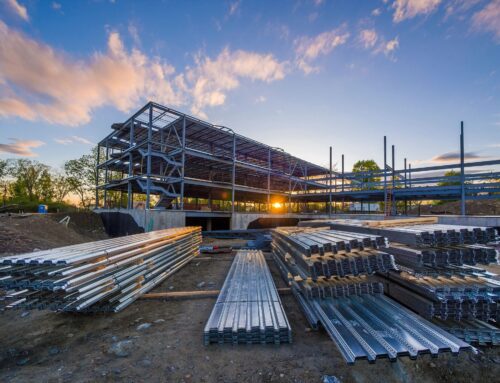Achieving Net Zero on residential developments
As the UK aims to reach its net zero target – bringing carbon emissions down by at least 100% the 1990 levels – by 2050, achieving net zero in any building is vital. Not only are standards and regulations more and more stringent: prospective home buyers are more and more oriented towards sustainability and attracted by the lower utility bills.
But what does ‘net zero’ actually mean, and how can it be achieved in residential buildings?
What is Net Zero?
For a building to achieve net zero, it must generate at least as much energy as it consumes on an annual basis. These dwellings, also referred to as Zero Energy Buildings, greatly reduce carbon emissions. In the building’s SAP calculations, which underpin the Energy Performance Certificate (EPC) rate of a building, net zero is achieved when the score is equal to 100; if it scores over 100, the dwelling is a net exporter – producing more energy than it consumes – and is a ‘Positive Energy’ home.
How do you build a Net Zero home?
There are several factors to keep in mind when it comes to planning and building a dwelling with the smallest possible – ideally non-existent – carbon footprint; these include the structure, the materials, the technology in use, and the likely behaviour of future occupants.
In keeping with the previously discussed Energy Hierarchy, the UK government’s approach to net zero carbon homes has three main points, in order of priority:
- A ‘fabric first’ approach for a minimum Fabric Energy Efficiency Standard.
- Adopting on-site zero carbon technologies and ceasing the installation of gas boilers in new homes.
- Offset measures to compensate for any remaining emissions.
Fabric First
This approach consists of prioritising the fabric of the building itself, maximising the performance of its structure and materials to reduce the need for energy in the first place. This includes taking steps to optimise:
Insulation
a properly insulated dwelling is warmer in winter and cooler in summer, reducing or eliminating the need for mechanical means of air conditioning, making the home more energy efficient. The use of insulating materials in the walls and roof is fundamental; the higher the material’s resistance values (R-values), the more effective insulation is going to be, whatever the temperature and weather conditions outside.
Windows can be a weak spot when it comes to insulation, but the correct choice of materials can avoid heat dispersion. Maximising air-tightness is also particularly helpful, keeping out air drafts and keeping the temperature consistent. It is important to keep in mind, while choosing size, style, and placement of the windows, how much natural light will they be able to let inside the dwelling. Windows which let in the most sunlight and allow good air circulation when open in warm weather, will go a long way towards reducing the need for energy consumption of a dwelling for lighting as well as air conditioning.
Zero carbon technologies
Once a dwelling’s energy needs are reduced as much as possible, it’s time to shift the focus on how to best meet the remaining needs through the use of renewable energy – an essential step towards achieving net zero buildings. Sustainable power generation can be achieved through a variety of means:
Solar panels:
generally installed on a dwelling’s roof, or on the walls, photovoltaic panels can convert sunlight into electricity. As sunlight is everywhere, one may think that the more panels are present, the more clean energy the house is able to produce – and while maximising the space for solar panels is advisable, it is not the only factor at play.
The latitude of the building, the position of the panels and their tilt towards sunlight will all have an impact in their ability to capture sunlight and convert it into clean energy.
If connected to the power grid, the dwelling will be able to receive energy should the panels fall short at any point – and, in case more energy is produced on site than the dwelling needs, it can be exported back to the grid and sold to the energy company.
Wind turbines:
these turbines generate electricity through the harnessing of wind energy; in case of excess energy production, that too can be redirected to the grid. Small turbines can be successfully installed to provide energy for residential homes, but this should follow careful evaluation of the location: if the dwelling is built in an area with very little wind on average, it may not be the most viable option.
Geothermal systems:
geothermal systems use heat from the ground for water heating, and can be used for cooling as well. This system does not produce electricity, but rather uses the sustained temperature of the ground; it is often in use in places with hot springs or geothermal reservoirs near the Earth’s surface. This type of energy is still underutilised in the UK, with some notable exceptions such as Southampton, with a geothermal power station in operation since 1986, pumping energy to its district heating network.
Offset measures
If, despite all efforts, the dwelling was unable to reach net zero, there are two ways to compensate (offset) for this: either through a payment that considers the cost of this shortfall, or – a preferable option – through other interventions in the same area. For example, if a residential home is unable to achieve net zero, installing solar panels in a nearby school, or improving the insulation of another nearby building, will compensate for any carbon emissions that could not be avoided on site.
The construction stage
Finally, one more thing to consider is the construction stage: the act of building a new home does have a carbon footprint. Architects and developers should look for ways to limit these emissions right from the construction stage. For example, opting for recycled materials, sourcing the materials nearby, and decreasing the use of fossil fuels, are choices that do contribute to lowering carbon emissions associated with the build.
How Can Sustain Quality Help My Organisation?
When an organisation turns to us at Sustain Quality, they gain access to a team of professionals that are dedicated to providing services that help save on energy costs.
Sustainability consultants are incredibly knowledgeable in the steps that need to be taken to create net-zero buildings for organisations of all sizes.
Some of the assessments that may be used to best determine how you can meet net-zero energy include:
A net-zero building is the epitome of a high-quality building and property organisation. Our dedicated team offers sustainability consulting Nationwide that will help you achieve your sustainability goals.
We can help your organisation reduce carbon emissions and meet other environmental initiatives.






